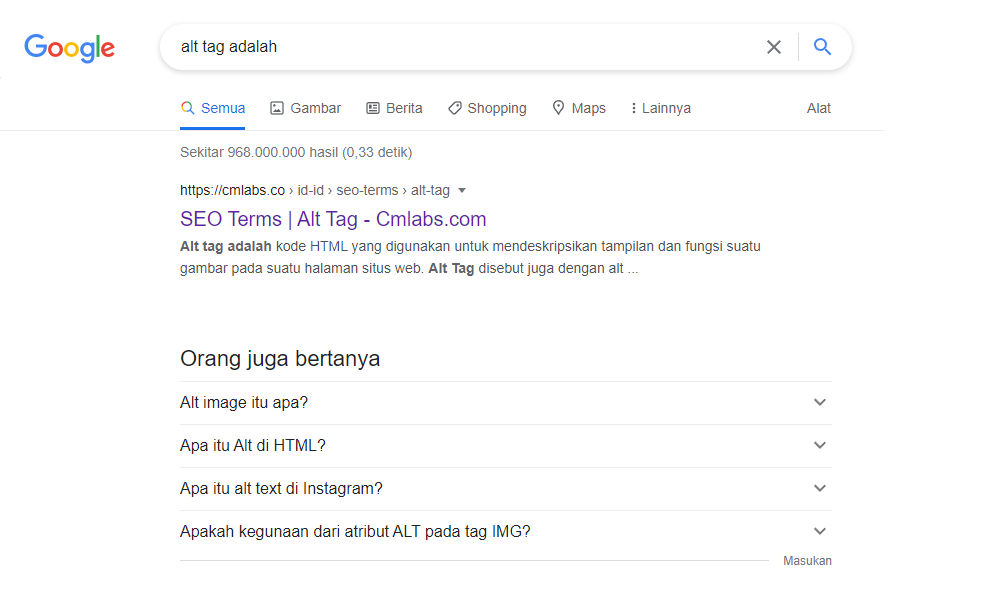We use cookies
This site uses cookies from cmlabs to deliver and enhance the quality of its services and to analyze traffic..
We use cookies
This site uses cookies from cmlabs to deliver and enhance the quality of its services and to analyze traffic..
Last updated: Jun 20, 2022
Disclaimer: Our team is constantly compiling and adding new terms that are known throughout the SEO community and Google terminology. You may be sent through SEO Terms in cmlabs.co from third parties or links. Such external links are not investigated, or checked for accuracy and reliability by us. We do not assume responsibility for the accuracy or reliability of any information offered by third-party websites.

As a web owner, you indeed want visitors to read more other content when they visit your website. Therefore, you insert some internal links to attract them and evoke curiosity.
Not only visitors, but you must also target the search engines to see your website as a relevant site and have a higher authority than competitors. So, it is important to understand the content cluster strategy.
Today, Google is not only looking for relevant keywords within a page but also synonyms and subtopics. Organizing content by topic will make it easier for users and search engines to find what they are looking for. Read a full explanation of this matter in the following guide.
A content cluster is a way of organizing content that can help users and search engines to find content based on specific topics. The content cluster strategy is one of the SEO tactics to optimize website structure and internal links by grouping content through pillar pages and clusters.
A pillar page is the main page that is focused on discussing a broader topic and targeting short-tail keywords with higher search volumes. Pillar pages tend to have longer content because they cover all aspects of the topic.
Meanwhile, cluster content serves to complete the pillar page. Cluster content contains a more detailed explanation of sub-topics that have a semantic relationship with the pillar page. Targeted keywords are usually less popular and less competitive.
This strategy aims to build web page authority so that your brand can be recognized as an expert in a particular niche. In addition, content clusters also allow you to present more content with other specific and relevant topics.
Content cluster not only makes Google think your site has high authority on a particular topic but also helps Google to understand the hierarchical structure of your website and see how your content is related to one another.
By creating a content cluster, you will have one main page (pillar page) with a more general discussion. For example, you focus on discussing an overview of SEO (Search Engine Optimization) on the pillar page.
You also have some supporting content (cluster content) containing more detailed topics, such as “backlink tips”, “on-page SEO”, and others. In addition, you also embed an internal link in the cluster content to go to the pillar page, because the two pages are interrelated.
As a result, Google will know that your site is focused on SEO topics because all content is centered on that pillar page. The number of internal links to the pillar page will make Google think that the page is the most important page so that the authority of the pillar page is higher.

The page structure within this strategy is composed of three main components, namely pillar pages, cluster contents, and hyperlinks. Check out the definition of the following content cluster structure.
Pillar page is a page that discusses a general topic. This page covers all aspects of the topic that you want to optimize in the SERP, but is not covered in depth. It aims to provide space for you to produce supporting cluster content with more specific related topics.
Cluster content is a support page that contains content with an in-depth discussion of a topic. Topics in content clusters are usually developed from pillar pages. If the pillar page discusses the topic in general, then the cluster explains the topic in more detail by using long-tail keywords.
Cluster content can contain hyperlinks or internal links that link them to the pillar page.
Another component is hyperlinks or internal links. You can link interrelated pages by embedding URL links from one content to another. This will make it easier for search engines to find out the hierarchical structure and relevance between pages on your website.
The content cluster strategy provides several benefits for websites such as increasing page authority, increasing site rankings in organic search, and bringing in more traffic.
Here's how to create a content cluster that you can do to create quality content:
In building a pillar page, you need to map out five to ten core topics that describe user needs. Do not choose this topic based on guesswork. You can start by analyzing what kind of content users are searching for.
If needed, you can also do some simple research on your customers. The research can be in the form of surveys, interviews, or online research. That way, you can find out what they really need.
You can group each user issue into broad topic areas. Then, you can do keyword research to plan sub-topics or supporting content that will enrich the information on the core topic.
Choose more general keywords to describe the core topic on the pillar pages. On the other hand, to build cluster content, make sure to choose a number of long-tail keywords.
Map out content ideas that align with each of the core topics and related sub-topics. Then, cover all the core topics on the pillar page, but don't go into too much detail. This way, you can create clustered content that clarifies pillar pages.
The thing to consider in writing cluster content is to describe a unique topic. Do not write content on cluster pages to be too similar to other cluster pages to avoid keyword cannibalization.

After writing the content, you need to add internal links between pillar and cluster pages. This strategy will make it easier for Google bots to find, crawl, and index your content. Surely, this will give high authority to your web page.
Apart from writing new content, you can also improve old content and republish it as cluster content. You can do a short content audit to find out which content is relevant to the core topic, so you can update that content.
When implemented properly, content clusters can increase the number of keyword variants that will bring some traffic to your website.
However, content clusters that are not optimized properly or there are many similarities in a topic can lead to keyword cannibalization. This can make it difficult for Google to determine which content is most important and relevant.
To avoid keyword cannibalization on your website, you can follow these steps:
You can use SEO tools to check content scores. It could be the use of long-tail keywords on pillar pages can further optimize the performance of content in organic search.
You need to check the titles and headings used in the content. Make sure they both contain a unique target keyword from the rest of the cluster content. So that information is more easily found by users and search engines.
Double check that you have added internal links to the pillar page. If not, add it immediately. You should link the pillar page in the navigation menu or in the footer section of the web page. That way, pillar pages can get better rankings.
That is an in-depth discussion of the content cluster strategy that can be applied to your website. It is undeniable that this content cluster strategy is able to make web page authority and rank better. However, keep in mind that to achieve the best results, of course, it will take a long time.
WDYT, you like my article?